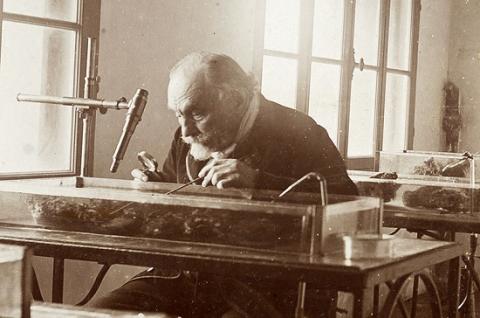
Henri de Lacaze-Duthiers, pioneering scientist
The man who created the marine stations of Roscoff and Banyuls-sur-Mer, Henri de Lacaze-Duthiers was a professor, anatomist, zoologist and biologist. This year, we celebrated the bicentenary of his birth.
A portrait of an eminent French scientist.
Born in 1821 in the Lot-et-Garonne, Henri de Lacaze-Duthiers was the son of the descendant of an old Gascon family, the baron de Lacaze-Duthiers. After his secondary education, he decided to leave his native region to study medicine and natural sciences in Paris, against the advice of his father who refused to finance his studies. In order to support himself, he became the assistant to Professor Milne-Edwards, the precursor of field observation and the first scientist to use a diving suit. He then brilliantly passed a medical thesis in 1851.
A few months later, in 1852, Napoleon III came to power and civil servants were required to take an oath. Henri de Lacaze-Duthiers, a zootechnics tutor at the Agronomic Institute of Versailles, categorically refused. He lost his job. This event would be at the origin of his vocation as a marine zoologist.
A formative voyage
In the middle of the 1850's, the naturalist made a trip to the Balearic Islands, which was transformative for him. He began fastidious work on acephalous mollusks and anomies with pearly shells. He tells in one of his diaries: "I could easily make an extensive study of the genital organs of the Acephalus; I had Anomias in large enough quantity to study all of its anomalies; the small and notched oysters formed benches almost with water level which allowed me to study their development." During this same period, he continued his research on mollusk species in France, on the Breton coasts, and more precisely in Saint-Jacul-de-la-Mer. This was his first contact with the Roscoff area. "I finally found a place where there were plenty of things to work on," he says.
Back at the capital, he became a professor of zoology at the Faculty of Science in Lille, alongside Louis Pasteur, who was the dean at the time.
In 1858, he began studying coral and published a book on the subject (Histoire naturelle du corail) which established his reputation as a naturalist.
Everything else followed: he became an associate professor at the École Normale Supérieure, a professor at the Muséum National d'Histoire Naturelle, and the head of the chair of zoology, anatomy and comparative physiology at the Sorbonne. He taught there for thirty-two years.
The creation of the marine stations of Roscoff and Banyuls
The years 1870-1880 were particularly important years in his life. He carried out two projects that were close to his heart: the creation of two marine zoology laboratories, one in Roscoff in 1872 and the other in Banyuls-sur-Mer (then called the Arago laboratory) in 1881.
The idea of setting up a station in Roscoff came about in 1869 but the war interrupted his project. He devoted all his energy to the creation of this establishment, which began modestly with a simple house, a small boat and two sailors hired for the campaign. He also established a magazine called Archives de zoologie expérimentale et générale. In it, there is an article that states, "Three successive visits to Roscoff, where he had first gone in 1868, by chance on the advice of a bookseller in the Rue des Grès, had revealed to him on this still unknown beach, the richest field of exploration, and an almost complete picture of all our oceanic littoral fauna. His first idea was to establish a kind of central station, like a supply center rather than a laboratory, from which scientific caravans would leave to explore the coast during the summer season in a more and more extended radius."
Having grown tired of the climate in Brittany, which forced scientists to interrupt their research for many months of the year, Henri de Lacaze-Duthiers considered the creation of a station in the south of France. He succeeded in obtaining the support of the city of Banyuls which offered him a piece of land and an annual rent of 500 francs. As mentioned in Archives de zoologie expérimentale et générale: "The city of Banyuls alone had given 12,000 fr, the land, a rent of 500 francs for 20 years and a large fishing boat for the use of its inhabitants by subscription.
Deeply attached to the Arago laboratory and to the city, Lacaze-Duthiers requested in his will that he be buried near it, facing the sea, and that the laboratory be donated to the Sorbonne.
At the end of the 1890s and since then, the Arago laboratory and the Roscoff station have been places of rich encounters between scientists, notably during zoological excursions.
A flourishing author
Henri de Lacaze-Duthiers wrote more than 250 scientific publications, among the best known: Recherches sur l'armure génitale femelle des insectes, Paris, L. Martinet, 1853, Histoire de l'organisation, du développement, des mœurs et des rapports zoologiques du dentale (Paris, 1858), Histoire naturelle du corail, organisation, reproduction, pêche en Algérie, industrie et commerce (Paris, 1864) and Faune du Golfe du Lion: coralliaires, zoanthaires sclerodermés (Paris, 1897).
